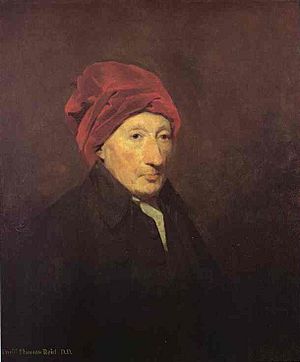George Turnbull (theologian) facts for kids
George Turnbull (born July 11, 1698 – died January 31, 1748) was a Scottish thinker. He was a philosopher, teacher, and writer. He is known as an early figure in the Scottish Enlightenment. This was a time when many new ideas about science, philosophy, and society came from Scotland.
Turnbull taught at Marischal College in Aberdeen. He also worked as a private tutor. Later, he became a clergyman in the Anglican church. He wrote books about moral philosophy, which is about how people should live and act. He also influenced Thomas Reid, another important Scottish philosopher. Turnbull was the first person from the Scottish Enlightenment to write a major book about education.
Contents
George Turnbull's Life Story
Early Life and Education
George Turnbull was born on July 11, 1698. His hometown was Alloa in Scotland. His father was a minister, and George was the third of nine children.
He started studying at the University of Edinburgh in 1711. In 1717, he began studying to become a minister. He earned his MA degree in 1721. While in Edinburgh, he joined a group of smart people called the Rankenian Club. Here, he met friends like George Young and William Wishart.
Turnbull wanted to create a way of understanding Christianity using reason. He even wrote an essay about how different religions should be tolerated. This essay was never published.
Teaching Career in Aberdeen
On April 14, 1721, Turnbull became a teacher at Marischal College in Aberdeen. He wrote two important papers there. One was about connecting natural science with moral philosophy. The other was about the beauty of the world.
These papers showed that Turnbull was the first Scottish thinker to suggest using the "Newtonian method" for moral philosophy. This method uses careful observation and reason, like how Isaac Newton studied physics. Turnbull also used ideas from Lord Shaftesbury. Even with new ideas, Turnbull loved the teachings of ancient moral philosophers.

Turnbull was a popular teacher. He had a lasting impact on students like Thomas Reid. However, he decided to leave Marischal College. He had disagreements with the college principal, Thomas Blackwell. Turnbull left without permission to become a tutor for the Udney family. He officially resigned in 1727.
Later Life and Travel
After leaving Marischal College, Turnbull continued to work as a tutor. He traveled across Europe. He then received another degree from the University of Edinburgh.
Turnbull decided he wanted to work in the Anglican church. He enrolled at Exeter College, Oxford, in 1733. He earned a BCL degree there.
Money problems forced Turnbull to tutor again. He spent two years in Italy, tutoring the son of Lord Rockingham. In 1737, he became a priest. This helped him join important social circles. In 1741, he became a chaplain to the Prince of Wales. A year later, he became a rector in Drumachose. In 1744, he became the tutor for Horace Walpole.
George Turnbull's Writings
Key Books and Ideas
During the 1730s and 1740s, Turnbull published many books and pamphlets. These often focused on his religious ideas.
In 1731, he published a small book. It was called A philosophical enquiry concerning the connexion betwixt the doctrines and miracles of Jesus Christ. In this book, he argued that miracles confirm Christian teachings. He said this was like how experiments confirm scientific theories.
In 1732, Turnbull wrote a critique of Matthew Tindal. This work was titled Christianity neither False nor Useless, Tho' not as Old as the Creation. It discussed the relationship between natural religion and revealed religion. Natural religion is about understanding God through nature. Revealed religion is about understanding God through holy texts.
Art, Morals, and Education
In 1740, Turnbull published A Treatise on Ancient Painting. He believed that fine arts, like painting, were useful for education. He thought painting was a language that shared ideas about life, philosophy, and nature. This book included drawings by Camillo Paderni.
Later that year, he published a short religious work. It was called An Impartial Enquiry into the Moral Character of Jesus Christ. In this book, Turnbull presented Jesus Christ as the greatest moral philosopher.
He also published his most important philosophical ideas in The Principles of Moral and Christian Philosophy. This book used his old lectures from Aberdeen. It also included ideas from his talks with philosophers in Europe.
Turnbull's last major work was published in 1742. It was called Observations upon Liberal Education. In this book, he suggested new ways to organize knowledge. He also proposed changes to what universities should teach.
George Turnbull died in The Hague on January 31, 1748. The reason for his death is not known.

